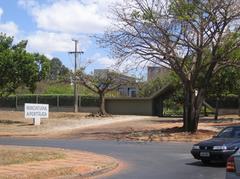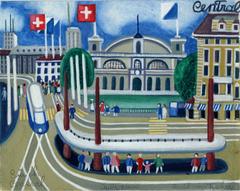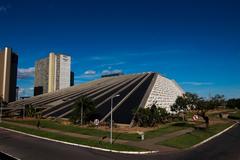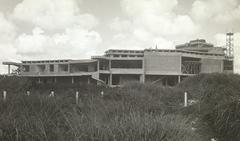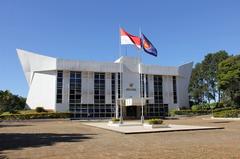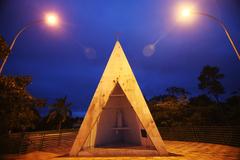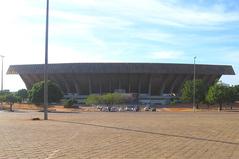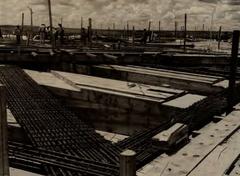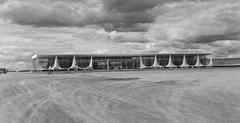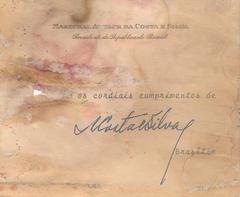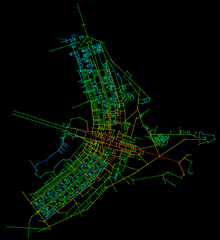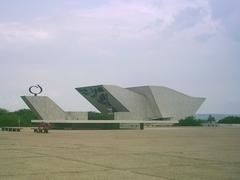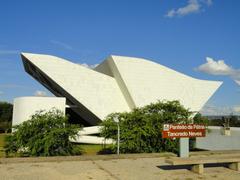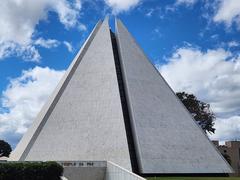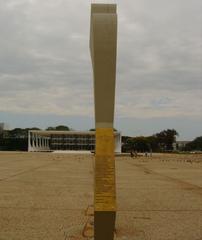Itamaraty Palace: Visiting Hours, Tickets, and Historical Significance in Brasília
Date: 14/06/2025
Introduction
The Itamaraty Palace, also known as the Palace of the Arches, is an architectural and diplomatic treasure situated in the heart of Brasília. As the headquarters of Brazil’s Ministry of Foreign Affairs, it stands not only as a symbol of the country’s modernist architectural movement but also as a testament to Brazil’s commitment to openness, diplomacy, and cultural identity. This comprehensive guide details the palace’s origins, architectural highlights, cultural significance, visiting hours, ticketing procedures, accessibility, and travel tips to help you plan a rewarding experience at one of Brasília’s most important historical sites (ArchDaily; 360 Meridianos; Google Arts & Culture).
Origins and Historical Evolution
From Rio de Janeiro to Brasília
The Itamaraty Palace’s lineage traces back to its namesake in Rio de Janeiro, which housed Brazil’s Ministry of Foreign Affairs for over seventy years. The term “Itamaraty” is rooted in the Tupi language, meaning “river of small stones,” highlighting Brazil’s indigenous heritage and the ministry’s embrace of diversity (Funds for NGOs; 360 Meridianos).
In 1960, Brasília was inaugurated as the new federal capital under President Juscelino Kubitschek, prompting the construction of a new Itamaraty Palace, which officially opened on April 21, 1970 (Wikipedia; ArchDaily).
Architectural Context and Symbolism
Oscar Niemeyer, a pioneer of Brazilian modernism, designed the palace as a celebration of form, transparency, and national identity. The building’s most distinctive feature is its colonnade of 28 monumental concrete arches, which appear to float above a serene reflecting pool. This design, set amidst the Ministries Esplanade near the National Congress, not only embodies Niemeyer’s philosophy of sensual, curvaceous lines but also symbolizes diplomatic openness and clarity (Arquitectura Viva; 360 Meridianos).
The palace’s integration with gardens designed by Roberto Burle Marx and the inclusion of works by artists like Athos Bulcão and Candido Portinari create a unique fusion of architecture, landscape, and art (About Brasília).
Diplomatic and Institutional Significance
“Itamaraty” as a Symbol
Within Brazil, “Itamaraty” is synonymous with the Ministry of Foreign Affairs, reflecting the palace’s central role in the nation’s diplomatic history. Since its establishment in 1822, the ministry has championed peaceful conflict resolution and multilateralism, bolstering Brazil’s reputation on the international stage (Wikipedia; Wikipedia; The Cairo Review).
A Stage for Diplomacy
The palace is renowned for hosting international summits, state visits, treaty signings, and grand receptions, including presidential inauguration banquets. Its art collection showcases works by Brazilian masters and international artists, while the upper floor preserves Princess Isabel’s desk, used to sign the Lei Áurea, which abolished slavery in Brazil—a powerful symbol of Brazil’s dedication to human rights (360 Meridianos; About Brasília).
Training Diplomats: The Rio Branco Institute
Housed within the palace, the Rio Branco Institute is Brazil’s foremost diplomatic academy, responsible for cultivating the country’s next generation of diplomats (Thomaskellner.com; The Cairo Review).
Visiting Hours, Tickets, and Visitor Information
Hours and Admission
- Open: Tuesday to Sunday, 9:00 AM – 5:00 PM
- Closed: Mondays and public holidays
- Admission: Free; guided tours require advance reservation (TripHobo; Itamaraty Official Website)
Guided Tours
Guided tours are available in Portuguese, with English and Spanish tours offered upon request and prior arrangement. Tours provide enriching insights into the palace’s architecture, history, and art. Booking in advance is highly recommended due to security protocols and limited group sizes.
Accessibility
The palace is fully accessible, with ramps, elevators, and accessible restrooms for visitors with mobility challenges.
Location and Getting There
Located at Esplanada dos Ministérios, Bloco H, the palace is easily reached by public transportation, taxi, or by walking from nearby landmarks, including the National Congress and the Cathedral of Brasília (TripHobo).
Practical Tips
- Advance Booking: Essential, especially for non-Portuguese speakers or groups.
- Identification: Required for entry.
- Dress Code: Smart casual attire is recommended.
- Photography: Allowed in most public areas, but restrictions may apply in certain rooms or during official events.
- No On-site Café: Dining options are available nearby in Brasília’s Monumental Axis area.
Visitor Experience: What to Expect
Arrival
Upon arrival, visitors are greeted by the palace’s iconic arches reflected in its tranquil pool. After a security check, guides lead visitors through the main reception hall, ceremonial rooms adorned with Brazilian art, and the renowned gardens designed by Roberto Burle Marx (WeGoTrip).
Highlights
- Main Hall: Column-free and bathed in natural light.
- Ceremonial Rooms: Display Brazilian and international artworks.
- Gardens and Pool: Feature native flora and sculptures, notably Bruno Giorgi’s “Meteoro.”
- Art Collection: Includes works by Athos Bulcão, Candido Portinari, and others.
Cultural Importance and National Identity
The Itamaraty Palace’s architectural innovation, artistic integration, and central role in diplomacy make it a keystone of Brazilian cultural identity. Its presence alongside other government buildings, such as the National Congress and Planalto Palace, underscores its significance within the political and cultural heart of the capital (The Guide; Arquitectura Viva).
The palace is also a UNESCO World Heritage site, lauded for its contribution to Brasília’s status as a planned city and modernist urban masterpiece.
Visiting Tips and Best Times
- Best Time: Weekday mornings, especially during the dry season (April–July) for pleasant weather (Brazil Pulse).
- Combine with Nearby Sites: The palace is close to the National Congress, Cathedral of Brasília, Palácio da Alvorada, and the TV Tower (BigBlueStone).
- Allow at Least One Hour: Standard guided tours last about an hour—ideal for fitting into a half-day city itinerary (TripHobo).
Frequently Asked Questions (FAQ)
Q: What are the visiting hours?
A: Tuesday to Sunday, 9:00 AM to 5:00 PM; closed on Mondays and public holidays.
Q: Is there an admission fee?
A: No, admission is free, but advance booking is required for guided tours.
Q: Are tours available in English?
A: Yes, but must be requested in advance.
Q: Is the palace accessible?
A: Yes, with ramps, elevators, and accessible restrooms.
Q: Can I take photos inside?
A: Generally permitted, but restrictions may apply in certain areas or during official events.
Q: How do I book a tour?
A: Reserve through the official Itamaraty Palace website, by phone, or at the visitor center.
Nearby Attractions
- National Congress: Iconic legislative complex.
- Cathedral of Brasília: Renowned for its hyperboloid design.
- Palácio da Alvorada: Presidential residence.
- TV Tower: Offers panoramic city views.
- Museum of the Republic: Modern art and history exhibits.
Visuals and Enhancements
Recommended images for your visit:
- Exterior: Palace arches reflected in the pool.
- Interior: Column-free main hall and spiral staircase.
- Gardens: Native flora designed by Roberto Burle Marx.
- Artworks: Featured during diplomatic events.
For a virtual preview, consult the official website’s interactive maps and online galleries.
Official Sources and Further Reading
- ArchDaily
- 360 Meridianos
- Google Arts & Culture
- TripHobo
- Itamaraty Official Website
- Funds for NGOs
- About Brasília
- Wikipedia
Conclusion
The Itamaraty Palace is a living symbol of Brazil’s diplomatic tradition, architectural innovation, and cultural richness. Its seamless blend of modernist design, art, and landscape, along with its pivotal role in foreign affairs, makes it an essential destination for visitors to Brasília. For the most current visiting hours and tour information, always refer to official sources. Enhance your experience with mobile guides and explore the city’s modernist heritage by including nearby landmarks in your itinerary.
For updates and travel tips, download the Audiala app and follow us on social media.
